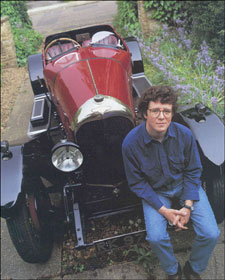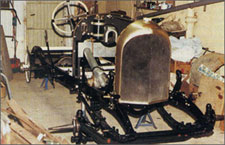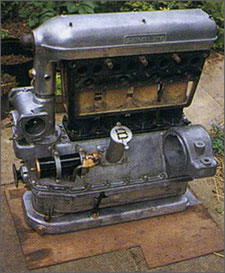
|
 |
 |
 |
Hay
assembled his 'bitsa' 3 litre
using ingenuity and widely
sourced parts, over eight years |
 |
Most of us give up any hope of owning
our dream car, but spiralling values of vintage Bentleys
in the early '80s didn't deter a teenage Michael Hay:
"It was a book in our school library called Cars,
Cars, Cars that really switched me on. On the back
cover was an overhead shot of a 1926 3-litre Speed Model."
Although Michael was only 14, that image triggered a
craving to own one.
"In 1981, I was unlucky enough to be involved in
a bicycle accident which landed me in hospital for three
months, followed by another six struggling around on
crutches. However, with the £3000 insurance money
I started seriously looking for a Bentley. By then I
was 17 and had already met several owners including
Tim Houlding. He had a built, 4½ litre from scratch
between '77 and '81 and his was the first Bentley I
rode in. That exhilarating late-night ride will never
be forgotten."
Hay hit gold when he spotted an advert in November 1982:
"I caught a train up to see the owner, Douglas
Miller. What remained was a chassis frame, front and
rear axles, a radiator and a steering column, which
was better than it sounds. It took all my insurance
money. The removal company that transported the parts
down to St Albans joked about my delivery of scrap when
it finally arrived."
This discovery had started life as a 3-litre model with
saloon coachwork by Harrison. It had been broken up
in 1960: "The chassis had been really butchered.
To shorten it from 10ft 10in to 9ft 9½in they
had cut it and crudely arc-welded 1/4in plate on each
side. The car had also been involved in an accident
as the front dumb irons were twisted. The track rods
were missing, the radiator shell was cracked and the
front axle had no brake linkages or backplates."
It needed great imagination to see
a finished car in the remains lying on the drive but
Hay was inspired. It would be another four years before
he passed his driving test, so trips in the quest for
spares were by bicycle or train.
 |
 |
 |
 |
This,
assembled, is the extent of
the first pile of bits Hay bought in '82 |
 |
Hay had joined British Aerospace in
1983 and trained as an engineer, which proved useful
during the long rebuild. "Much of the car went
in there and I came to know the sandblaster really well.
Some aluminium welding was also done at work but most
of the car was built in my parents' garden shed or a
nearby lock-up."
Toughest task was finding the mass of missing parts:
"I'd been a member of the BDC since I was 14, so
I was by then pretty familiar with the cars. Over the
years I collected bits from all corners of the country.
My luckiest find was a cheap cylinder block which turned
out to be better than expected. The engine I built myself,
with the exception of the line boring."
"Often I would salvage and repair parts that other
owners had discarded. The back axle I built up. It needed
a new crown wheel and pinion as it had at one time run
out of oil and was in a real mess. I made the shackles,
the kingpins and the brake rods from scratch."
The backplates are typical of Hay's ingenuity. He found
a set that had been converted to hydraulics. To return
to Perrot mechanical spec' he machined a block of Duralumin
for each mounting bracket and fixed these with 'Hysol',
a cold setting adhesive used on aircraft door frames.
"They would have cost me £200 each to replace
and I built the pair for £40."
The gearbox was his biggest nightmare:
"The gears were worn but usable, but I had to remake
many of the missing parts including the complete gearlever
shaft from scratch."
Competition for parts was a problem, particularly with
Hay's limited budget. One enquiry was typical when the
vendor asked: "How many 8-litres do you have?"
"I have one 3-litre and most of it is under my
bed," was Hay's response. His eccentric case not
surprisingly endeared him to owners and specialists.
 |
 |
 |
 |
| Engine block —
a lucky, cheap find |
 |
By January 1987 the Bentley was a rolling
chassis although much of it was still mocked up. The
body kit came as a pile of wood: "The cost to have
one built professionally was by then outrageous. There
were no drawings but the joints had been marked. I had
no experience at woodwork, so I cut out the joints with
my milling machine and chiselled out the radius. The
body was assembled in the garden one summer holiday."
Slowly the car started to take shape, the scuttle was
built, the wiring done and the dash fitted but certain
parts were still elusive. It took Hay three years to
put together a deal for a dynamo which eventually included
a complex transaction involving three parties swapping
bits.
By June 1990 Hay was close to start-up but he didn't
quite make his target of the last BDC rally at Hatfield
House. The starter motor running backwards didn't help.
For the first year the Bentley became known as 'the
air conditioned special': "With its uncovered body
it was very draughty, but I just wanted to learn to
drive it — all I'd driven up to that point was
a Morris Marina. There is no secret about driving a
Bentley and, providing the car is set up correctly,
it's very logical."
A return to student life to study philosophy has prevented
Hay from using the Bentley on a regular basis hut, since
completion in 1990, he has covered more than 25,000
miles. "It's still an unrivalled experience driving
it alone on quiet country roads and, whenever I can,
I get out behind the wheel."
|